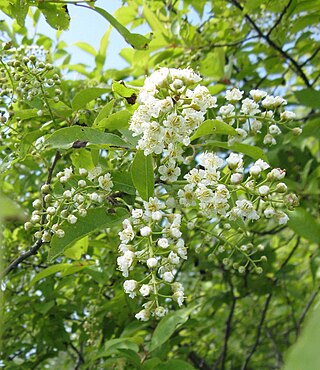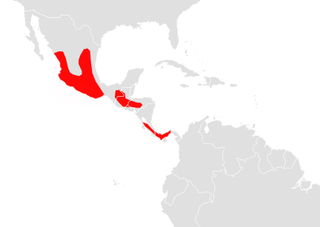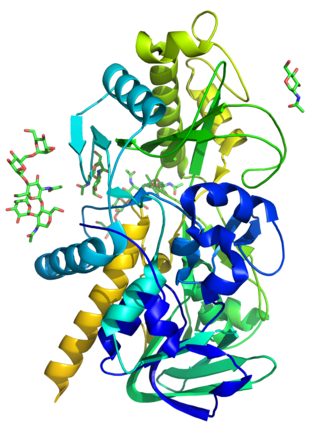
A cherry is the fruit of many plants of the genus Prunus, and is a fleshy drupe.

Prunus is a genus of trees and shrubs in the flowering plant family Rosaceae that includes plums, cherries, peaches, nectarines, apricots, and almonds. The genus has a cosmopolitan distribution, being native to the North American temperate regions, the neotropics of South America, and temperate and tropical regions of Asia and Africa, There are 340 accepted species. Many members of the genus are widely cultivated for their fruit and for decorative purposes. Prunus fruit are drupes, or stone fruits. The fleshy mesocarp surrounding the endocarp is edible while the endocarp itself forms a hard, inedible shell called the pyrena. This shell encloses the seed, which is edible in some species, but poisonous in many others. Besides being eaten off the hand, most Prunus fruit are also commonly used in processing, such as jam production, canning, drying, and the seeds for roasting.

The cherry blossom, or sakura, is the flower of trees in Prunus subgenus Cerasus. "Sakura" usually refers to flowers of ornamental cherry trees, such as cultivars of Prunus serrulata, not trees grown for their fruit. Cherry blossoms have been described as having a vanilla-like smell, which is mainly attributed to coumarin.

Pinus serotina, the pond pine, black bark pine, bay pine,marsh pine, or pocosin pine, is a pine tree found along the Southeastern portion of the Atlantic coastal plain of the United States, from southern New Jersey south to Florida and west to southern Alabama. Pond pine distribution may be starting to spread west towards Mississippi and Tennessee.

Prunus virginiana, commonly called bitter-berry, chokecherry, Virginia bird cherry, and western chokecherry, is a species of bird cherry native to North America.

Prunus subg. Padus is a subgenus of Prunus, characterised by having racemose inflorescences. Padus was originally a distinct genus, but genetic and morphological studies have shown that Padus is polyphyletic. It has been proposed that all the racemose taxa within Prunus are incorporated into a broad-sense Prunus subg. Padus.

Prunus serotina Ehrh., commonly called black cherry, wild black cherry, rum cherry, or mountain black cherry, is a deciduous tree or shrub in the rose family Rosaceae. Despite being called black cherry, it is not very closely related to the commonly cultivated cherries such as sweet cherry, sour cherry and Japanese flowering cherries which belong to Prunus subg. Cerasus. Instead, P. serotina belongs to Prunus subg. Padus, a subgenus also including Eurasian bird cherry and chokecherry. The species is widespread and common in North America and South America.

Ulmus serotinaSarg., the September elm, is an autumn-flowering North American species of tree. It is uncommon beyond Tennessee; it is only very locally distributed through Illinois, Kentucky, Arkansas, Mississippi, Oklahoma, Alabama, and Georgia, and disjunct populations into Nuevo León, Mexico. It grows predominantly on limestone bluffs and along streams to elevations of 400 m.

The Aztec fruit-eating bat is a species of bat in the family Phyllostomidae.

The enzyme (R)-mandelonitrile lyase (EC 4.1.2.10, (R)-HNL, (R)-oxynitrilase, (R)-hydroxynitrile lyase) catalyzes the chemical reaction
Abagrotis orbis, the well-marked cutworm or Barnes' climbing cutworm, is a moth of the family Noctuidae. The species was first described by Augustus Radcliffe Grote in 1876. It is in southwestern North America, extending eastward across the plains and with a large disjunct population in dune habitats in the southern Great Lakes area. It extends into western Canada only in the southern interior of British Columbia and southern Alberta and Saskatchewan.

Catocala ultronia, the dark red underwing or ultronia underwing, is a moth of the family Erebidae. The species was first described by Jacob Hübner in 1823. It is found in most of eastern North America, south to Florida and Texas. It ranges west across the southern parts of Canada to extreme southeast British Columbia.

Leucocyanidin is a colorless chemical compound that is a member of the class of natural products known as leucoanthocyanidins.
Stigmella slingerlandella, the plum leaf miner, is a moth of the family Nepticulidae. It is found in North America from Ontario, New York, Michigan and Ohio, possibly south to Florida. It was named in honour of Mark Vernon Slingerland.

Prunus avium, commonly called wild cherry, sweet cherry or gean is a species of cherry, a flowering plant in the rose family, Rosaceae. It is native to Europe, Anatolia, Maghreb, and Western Asia, from the British Isles south to Morocco and Tunisia, north to the Trondheimsfjord region in Norway and east to the Caucasus and northern Iran, with a small isolated population in the western Himalaya. The species is widely cultivated in other regions and has become naturalized in North America, New Zealand and Australia.
Wild cherry is a common name for species of cherries growing outside of cultivation, especially:

Phyllonorycter crataegella, the apple blotch leafminer, is a moth of the family Gracillariidae. It is known from Canada the United States.
Argyrotaenia quadrifasciana, the four-lined leafroller moth, four-banded leafroller or lesser all-green leafroller, is a species of moth of the family Tortricidae. It is found in North America, where it has been recorded from Nova Scotia to West Virginia, west to Arkansas and north to Alberta. The habitat consists of orchards and shrubby areas.

Prunus alabamensis, the Alabama cherry or Alabama black cherry, is an uncommon or rare species of tree in the rose family endemic to parts of the Southeastern United States. It occurs in the states of Alabama, Florida, Georgia, Mississippi, and South Carolina. It is closely related to and found wholly within the range of Prunus serotina, the black cherry, a much more common and widespread species of Prunus that is also native to the region. Alabama cherry is sometimes considered to be a variety of Prunus serotina, however most authors treat it as a distinct species.

Prunus subg. Cerasus is a subgenus of Prunus. Species of the subgenus have a single winter bud per axil. The flowers are usually in small corymbs or umbels of several together, but some species have short racemes. The fruit is a drupe and has no obvious groove along the side. The subgenus is native to the temperate regions of the Northern Hemisphere, with two species in North America, four in Europe, two in North Africa, and the remainder in Asia.















